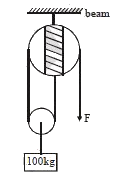Under which force the centre of mass is moving? Solution in Gujrati
Step by step video & image solution for Under which force the centre of mass is moving? by Physics experts to help you in doubts & scoring excellent marks in Class 11 exams.
Updated on:21/07/2023Topper's Solved these Questions
- SYSTEMS OF PARTICLES AND ROTATIONAL MOTIONBOOK - KUMAR PRAKASHANCHAPTER - SYSTEMS OF PARTICLES AND ROTATIONAL MOTIONEXERCISE - SECTION-B NUMERICALS
29 Videos
- SYSTEMS OF PARTICLES AND ROTATIONAL MOTIONBOOK - KUMAR PRAKASHANCHAPTER - SYSTEMS OF PARTICLES AND ROTATIONAL MOTIONEXERCISE - SECTION-B NUMERICALS FROM TEXTUAL EXERCISE
21 Videos
- SYSTEMS OF PARTICLES AND ROTATIONAL MOTIONBOOK - KUMAR PRAKASHANCHAPTER - SYSTEMS OF PARTICLES AND ROTATIONAL MOTIONEXERCISE - SECTION-A HOTS
3 Videos
- QUESTIONS ASKED IN JEE - 2020 BOOK - KUMAR PRAKASHANCHAPTER - QUESTIONS ASKED IN JEE - 2020 EXERCISE - Question
16 Videos
- THERMAL PROPERTIES OF MATTERBOOK - KUMAR PRAKASHANCHAPTER - THERMAL PROPERTIES OF MATTEREXERCISE - Question Paper (Section - D) (Answer following in brief :) Each carry 4 marks
1 Videos
Similar Questions
Find the centre of mass of three particles at the vertices of an equilateral triangle. The masses of the particles are 100g, 150g, and 200g respectively. Each side of the equilateral triangle is 0.5m long.
View SolutionGive the location of the centre of mass of a (i) sphere, (ii) cylinder, (iii) ring, and (iv) cube, each of uniform mass density. Does the centre of mass of a body necessarily lie inside the body ?
View SolutionWhat is torque? Explain the torque acting on a particle.
View SolutionA non-isotropic solid metal cube has coefficient of linear expansion as 5×10−5/∘C along the x-axis and 5×10−6/∘C along y-axis and z-axis. If the coefficient of volumetric expansion of the solid is n×10−6/∘C then the value of n is....
View SolutionIn an experiment on the specific heat of a metal, a 0.20 kg block of the metal at 150∘C is dropped in a copper calorimeter (of water equivalent 0.025 kg) containing 150 cm3 of water at 27∘C. The final temperature is 40∘C. Compute the specific heat of the metal. If heat losses to the surroundings are not negligible, is your answer greater or smaller than the actual value for specific heat of the metal ?
View SolutionIf there are no external forces, the centre of mass of a double star moves like a free particle. If we go to the centre of mass frame, then we find that the two starts are moving in a circle about the centre of mass, which is at rest.
View SolutionA truck of mass M is moved under a force F . If the truck is then loaded with an object equal to the mass of the truck and the driving force is halved, then how does the acceleration change?
View SolutionThe centre of mass of a body is moving with a uniform velocity of 10 cm//s . Three forces are applied on the body, which are in equilibrium. The velocity of centre of mass would become
View SolutionTwo particles of masses m and 3m are moving under their mutual gravitational force, around their centre of mass, in circular orbits. The separation between the masses is r. The gravitational attraction the two provides nessary centripetal force for circular motion The ratio of centripetal forces acting on the two masses will be
View SolutionShow that a system of particles moving under the influence of an external force, moves as if the force is applied at its centre of mass.
View SolutionShow that in absence of any external force the centre of mass of two moving particles moves with uniform velocity.
View Solution100 kg द्रव्यमान बल F के अधीन एक समान वेग से गति करता है। दण्डिका पर छत को जोड़ने वाली रस्सी के द्वारा लगने वाला बल होगा:

View SolutionA truck of mass M is moved under a force F. If the truck is then loaded with an object equal to the mass of the truck and the driving force is halved, then how does the acceleration change?
View SolutionIf no external force acts on the system
(a) Acleleration of centre of mass is zero
(b) Velocity of centre of mass is zero
(c ) Centre of mass may be at rest (or) moving with constant velocity
(d) Velocity and momentum of centre of mass remains constant
View SolutionStatement A : Whrn no external force acts on a body its centre of mass will be at rest or under uniform motion.
Statement B : When a force acts on a body at its centre of mass then will have only translation motion
View Solution
